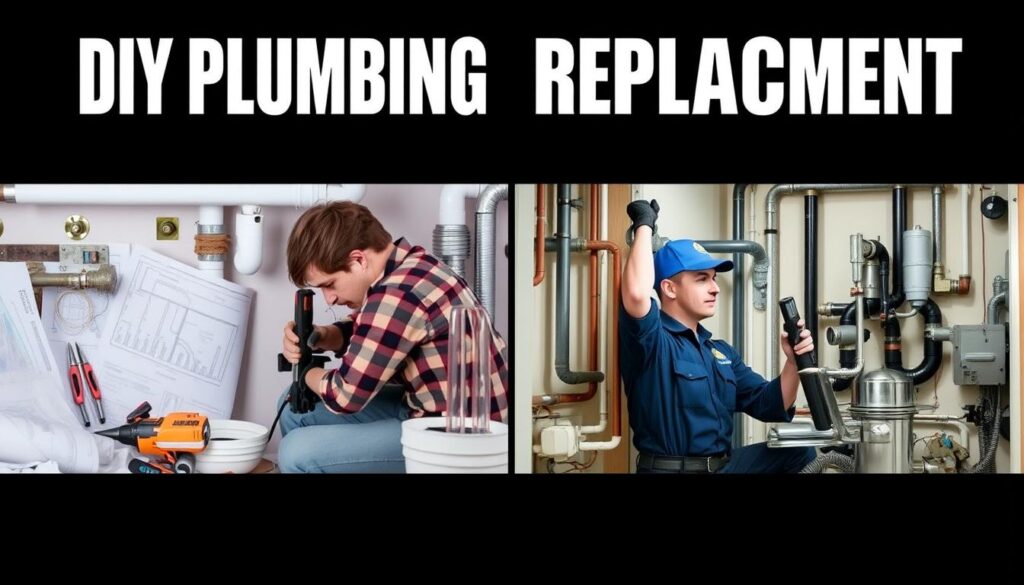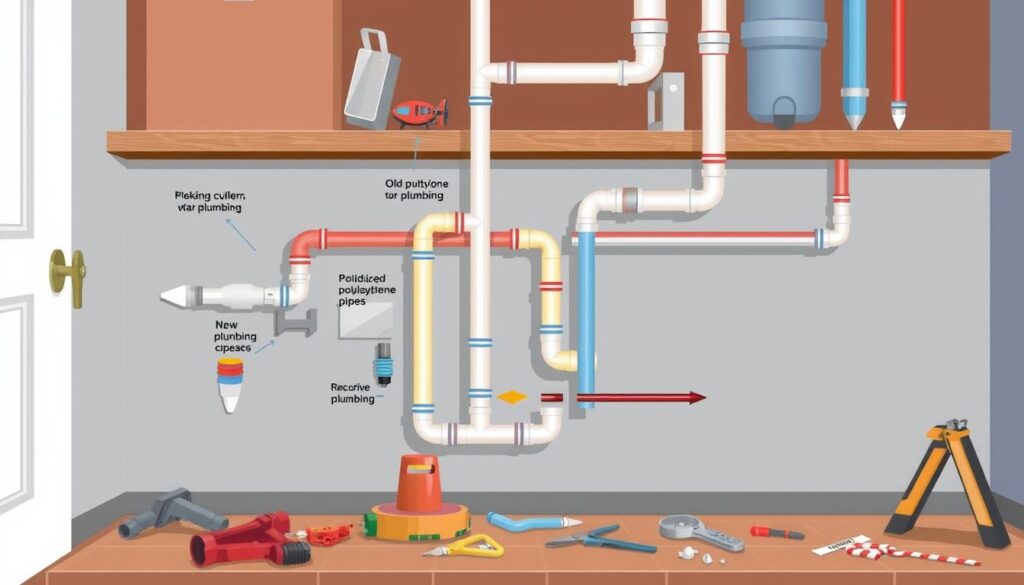Homeowners are looking to upgrade their plumbing systems, and the cost of replacing polybutylene pipes is a big concern. Polybutylene was once a common choice for plumbing but is now known to fail early. This guide offers the latest on replacing polybutylene plumbing in 2024. It includes average costs, what affects prices, and tips from experts to help plan your project.

Key Takeaways
- Polybutylene pipes, a once-popular plumbing material, are now known to be prone to failure, necessitating replacement.
- The average national cost to replace polybutylene plumbing in 2024 can vary significantly, depending on various factors.
- Homeowners should consider the cost factors, such as home size, additional materials, and labor, when budgeting for their plumbing replacement project.
- Professional installation is recommended, as it ensures the project is completed correctly and safely.
- Homeowners may be eligible for insurance coverage or government assistance programs to offset the costs of polybutylene pipe replacement.
Understanding Polybutylene Plumbing Systems
Polybutylene (PB) pipes were once common in homes built from 1978 to 1995. They were made from a flexible plastic material. This made them cheaper and easier to install than copper or steel pipes. But, PB pipes have many problems that make them need to be replaced in many homes.
What is Polybutylene Piping?
Polybutylene is a plastic material from the 1970s. It was made to be affordable for home plumbing. PB pipes were flexible and easy to install. They could handle high water pressure and temperature.
Why Polybutylene Pipes Need Replacement
- Oxidation: PB pipes can become brittle and crack or leak over time.
- Chemical Reactions: Chemicals like chlorine in water can damage PB pipes faster.
- Water Pressure Issues: PB pipes may leak under high water pressure, causing damage.
Historical Context and Installation Period
PB pipes were used a lot in the 1970s and 1980s. About 10 million homes in the U.S. had them. They were cheaper and easier to install than other pipes.
But, problems with PB pipes became clear. This led to a big need for new plumbing materials. Now, many homes with PB pipes need to replace them to avoid water damage.
Since the 1990s, fewer homes use PB pipes. Now, PEX and copper pipes are more popular. This means many homeowners with PB pipes need to replace them. This ensures their plumbing is safe and reliable.
Signs Your Home Has Polybutylene Pipes
Knowing if your home has polybutylene (PB) pipes is key. These pipes often fail and need to be replaced. Learning what PB pipes look like and where they are can help you find them early.
PB pipes are usually gray or blue and shiny. You can find them in basements, crawl spaces, or behind walls. They can become brittle and crack over time, causing leaks and water damage.
- Discoloration or yellowing of the pipes
- Visible cracks or splits in the pipe material
- Unexplained drops in water pressure or leaks around fittings
- Warping or bulging of the pipes
Seeing these signs might suggest PB pipes, but a pro plumbing check is best. Plumbing inspectors know PB pipes well and can check your home’s plumbing.
| Pipe Material | Characteristics | Typical Lifespan |
|---|---|---|
| Polybutylene (PB) | Smooth, gray or blue, prone to cracking and leaks | 15-25 years |
| Copper | Reddish-brown, durable, less susceptible to leaks | 50-70 years |
| PEX | Flexible, cross-linked polyethylene, resistant to corrosion | 40-50 years |
By knowing what polybutylene pipe characteristics look like and getting a plumbing inspection, you can find PB pipes. This helps you fix any problems before they get worse.
How Much Does It Cost to Replace Polybutylene Plumbing
Replacing polybutylene plumbing can be a big expense for homeowners. But knowing the average costs and key factors can help you plan your budget. Let’s explore the typical prices for this important home improvement project.
Average National Costs
Reports show the average cost to replace polybutylene plumbing is $3,000 to $15,000. This range shows the complexity of the job, like your home’s size and repair needs.
Cost Factors by Home Size
- Smaller homes (under 1,500 sq. ft.): $3,000 to $8,000
- Medium-sized homes (1,500 – 3,000 sq. ft.): $6,000 to $12,000
- Larger homes (over 3,000 sq. ft.): $10,000 to $15,000
Additional Material Expenses
When planning for a polybutylene replacement, remember extra material costs. This includes new fixtures, valves, and fittings. These can add $500 to $2,000 to your total cost.
Keep in mind, plumbing upgrade costs and home size plumbing expenses can differ a lot. Getting help from an experienced plumber can give you a better idea of what to expect for your polybutylene replacement pricing project.
Factors Affecting Replacement Costs
Replacing polybutylene plumbing can cost a lot, and the price changes based on several things. Knowing these factors helps homeowners plan for the costs.
The home’s layout and plumbing system’s complexity matter a lot. Homes with complex systems or hard-to-reach pipes cost more to fix. But, homes with simple plumbing systems might save money.
Regional price differences also affect the cost. Labor, materials, and permits can vary by area. This means costs can be higher in some places than others.
How much damage the pipes have caused is another big factor. If the pipes have damaged the home, fixing it will cost more. But, if the damage is small, the cost will be lower.
The cost to replace polybutylene plumbing depends on plumbing cost variables, home layout impact, and regional price differences. Knowing these helps homeowners get ready for the expenses of this project.
Modern Plumbing Alternatives for Replacement
Homeowners have many options when replacing old pipes. PEX, copper, and CPVC are popular choices. Each has its own benefits and things to consider. Knowing the pros and cons can help you choose the best for your home.
PEX Piping Options
PEX, or cross-linked polyethylene, is becoming more popular. It’s flexible, affordable, and easy to install. PEX resists corrosion and handles water temperature changes well. It also has fewer connections, which means fewer leaks.
Copper Plumbing Systems
Copper is a trusted choice for plumbing. It’s durable and resists corrosion. Copper pipes can last a long time and handle high water pressure. But, it’s pricier than other options and harder to install.
CPVC Alternatives
CPVC, or chlorinated polyvinyl chloride, is another good option. It resists corrosion and chemicals. CPVC is easy to install and can be cheaper than copper for smaller projects.
| Plumbing Material | Durability | Cost | Installation Complexity |
|---|---|---|---|
| PEX | High | Low | Low |
| Copper | High | High | High |
| CPVC | High | Moderate | Moderate |
When choosing between PEX vs copper plumbing or CPVC pipes, think about your needs and budget. Each material has its own strengths. By understanding these, you can pick the best for your home.
Professional vs. DIY Replacement Considerations
Homeowners must decide whether to replace polybutylene plumbing themselves or hire professionals. Both DIY plumbing replacement and hiring plumbing contractors have their pros and cons.
DIY plumbing can save money. If you know plumbing basics and have the right tools, you might save a lot. But, doing it wrong can cause leaks, water damage, and safety issues.
Hiring plumbing contractors means the job is done right. They have the skills and tools to replace pipes safely and efficiently. This option costs more but offers a professional guarantee and support.
Choosing between DIY plumbing replacement and hiring plumbing contractors depends on cost savings, risks, and your comfort with plumbing. Talking to local experts can help you decide what’s best for your situation.

| DIY Plumbing Replacement | Hiring Plumbing Contractors |
|---|---|
| Potential cost savings | Professional expertise and guarantees |
| Requires plumbing skills and tools | Eliminates risk of improper installation |
| Inherent risk of leaks and water damage | Ensures job is done correctly |
| Homeowner responsible for all aspects | Provides ongoing support and warranty |
Insurance and Financing Options
Replacing polybutylene plumbing can be expensive for homeowners. But, there are insurance and financing options to help. These alternatives make the upgrade more affordable.
Home Insurance Coverage
Many insurance policies cover plumbing system replacements, including polybutylene upgrades. It’s important to check your policy and talk to your insurance provider. Some policies cover the full cost, while others have limits or deductibles.
Available Payment Plans
If insurance doesn’t cover all costs, financing options are available. You can look into home equity loans, personal loans, or contractor payment plans. These options help spread out the cost over time, easing your budget.
Government Assistance Programs
Homeowners might qualify for government programs that fund home repairs, including plumbing upgrades. These programs vary by location. It’s key to research and see if you qualify in your area.
Exploring these options can help homeowners balance cost and convenience for plumbing replacements. With the right planning, the financial stress of this upgrade can be lessened.
Timeline and Project Planning
Replacing your home’s polybutylene plumbing system is a big job. It needs careful planning and coordination. Knowing the typical timeline helps you prepare and manage your expectations.
A full polybutylene plumbing replacement in a medium-sized home usually takes 3 to 7 days. This depends on the job’s complexity and your home’s size. It includes the initial assessment, getting permits, the replacement work, and final checks.
To have a smooth plumbing replacement duration, plan early. Start by setting up a meeting with a trusted local plumber who knows about polybutylene pipe replacement. They can give you a detailed timeline and help with the home renovation planning.
- Get your home ready by clearing the way to plumbing fixtures and appliances.
- Get any needed permits from your local government.
- Work with the plumbing contractor to keep the disruption to a minimum.
- Make sure you have enough time for the replacement work and any repairs to drywall or flooring.
- Book a final inspection to check if the new plumbing meets local codes and standards.
With a good plumbing project management plan, you can have a successful and smooth polybutylene pipe replacement. This way, it won’t disrupt your home and daily life too much.

| Task | Timeline |
|---|---|
| Initial Assessment and Estimate | 1-2 days |
| Permit Acquisition | 2-5 days |
| Physical Replacement Work | 2-5 days |
| Final Inspection and Cleanup | 1 day |
“Proper planning and preparation are the keys to a successful polybutylene plumbing replacement project.”
Conclusion
Replacing your home’s polybutylene plumbing system is a smart move. It brings many benefits. Upgrading to PEX or copper pipes makes your home safer from leaks and water damage.
This change not only boosts your home’s value but also improves your water quality. It gives you peace of mind for years to come.
The cost of replacing polybutylene pipes might seem high at first. But, the long-term benefits are worth it. Homeowners who make this change often see their homes sell for more.
Modern plumbing is a big plus for buyers. Plus, it saves on energy and maintenance costs, making it a smart investment.
Whether you do it yourself or get a professional, replacing polybutylene pipes is crucial. It protects your home and keeps its value high. Taking action now means a reliable plumbing system for years.
FAQ
What is polybutylene piping?
Polybutylene piping was used in homes from 1978 to 1995. It was cheap and easy to install. But, it often fails early, so it needs to be replaced.
Why do polybutylene pipes need to be replaced?
Polybutylene pipes can get brittle and leak or burst. This can cause water damage and expensive repairs. Replacing them is key to keeping your home safe and working well.
How can I identify if my home has polybutylene pipes?
Look for gray or blue, flexible pipes in places like basements or attics. If you’re not sure, a plumber can check and tell you what you have.
What is the average cost to replace polybutylene plumbing?
Replacing polybutylene plumbing costs between $3,000 and $10,000. This depends on your home’s size, pipe location, and repair needs. You might also need to buy new fixtures.
What factors affect the cost of polybutylene plumbing replacement?
Several things can change the cost. These include your home’s layout, pipe location, local labor costs, and repair needs. Each factor can affect the final price.
What are some modern plumbing alternatives for replacing polybutylene pipes?
You can choose from PEX, copper, or CPVC pipes. Each has its own benefits like durability and cost. Think about what’s best for your home when picking a replacement.
Should I hire a professional or attempt a DIY polybutylene plumbing replacement?
DIY might save money, but it’s risky. Replacing pipes needs special skills to do right. A professional plumber can ensure it’s done safely and works well.
Are there any financial assistance options available for polybutylene plumbing replacement?
Yes, there are ways to help pay for replacement. Home insurance, payment plans, and government programs might cover some costs.
How long does a polybutylene plumbing replacement project typically take?
The time needed varies by home size and pipe location. On average, it takes 3 to 10 days. More time is needed for prep and cleanup.



